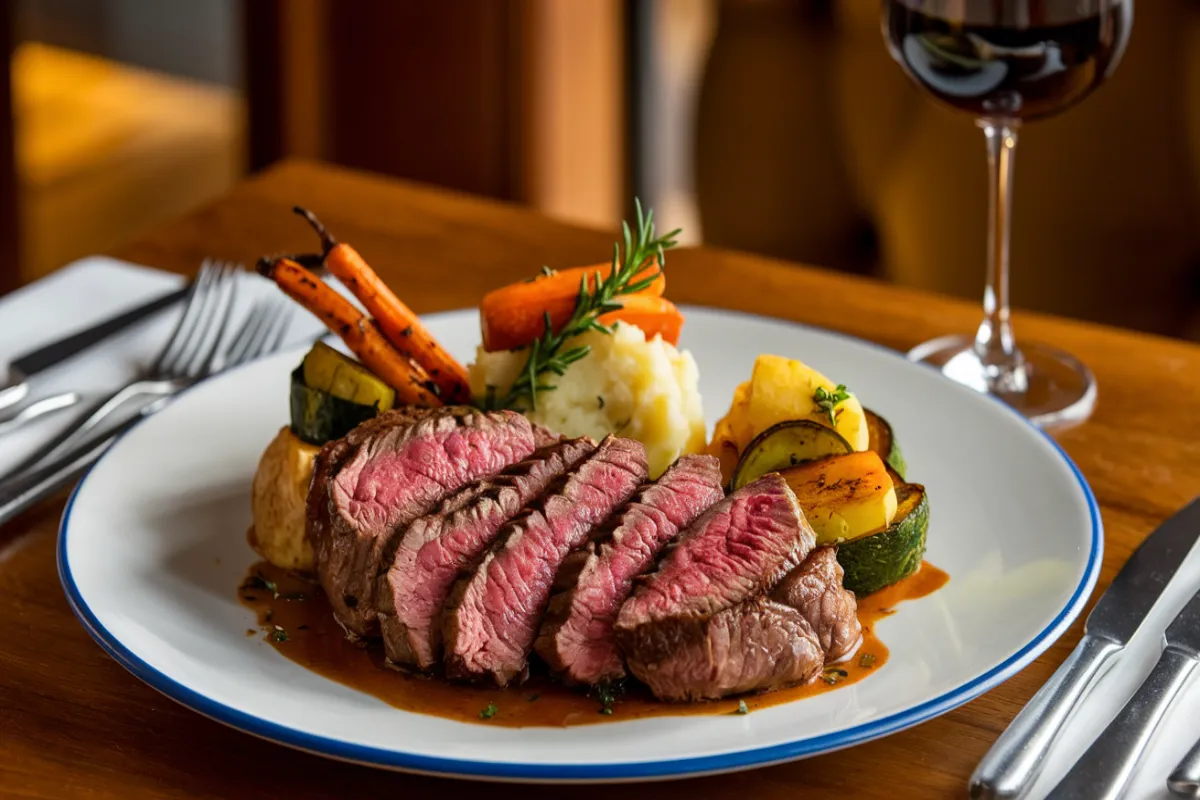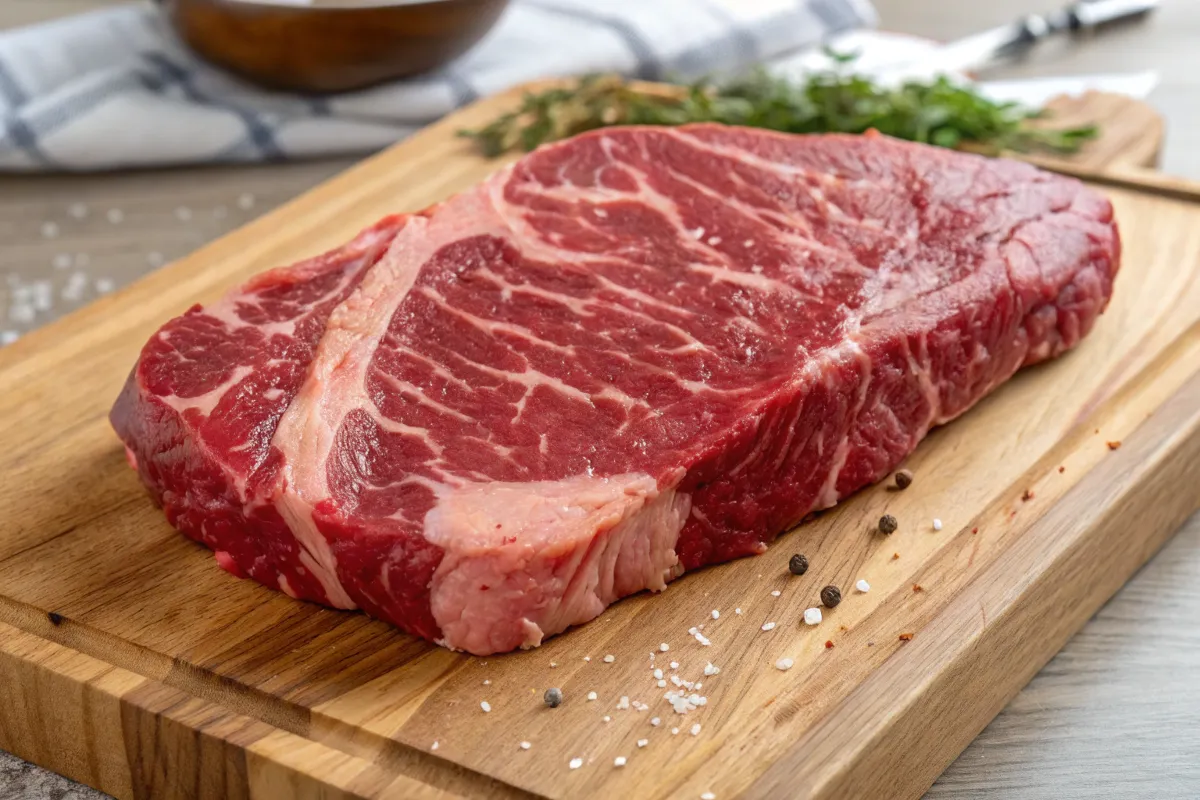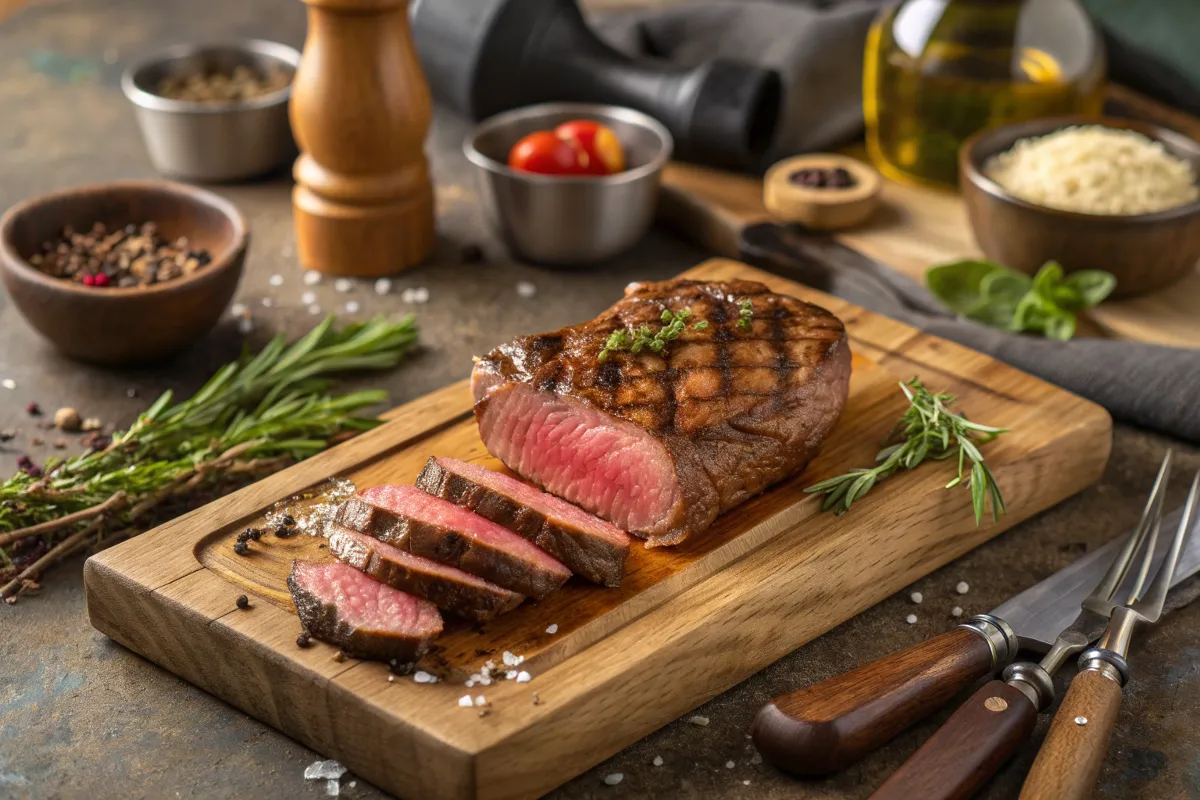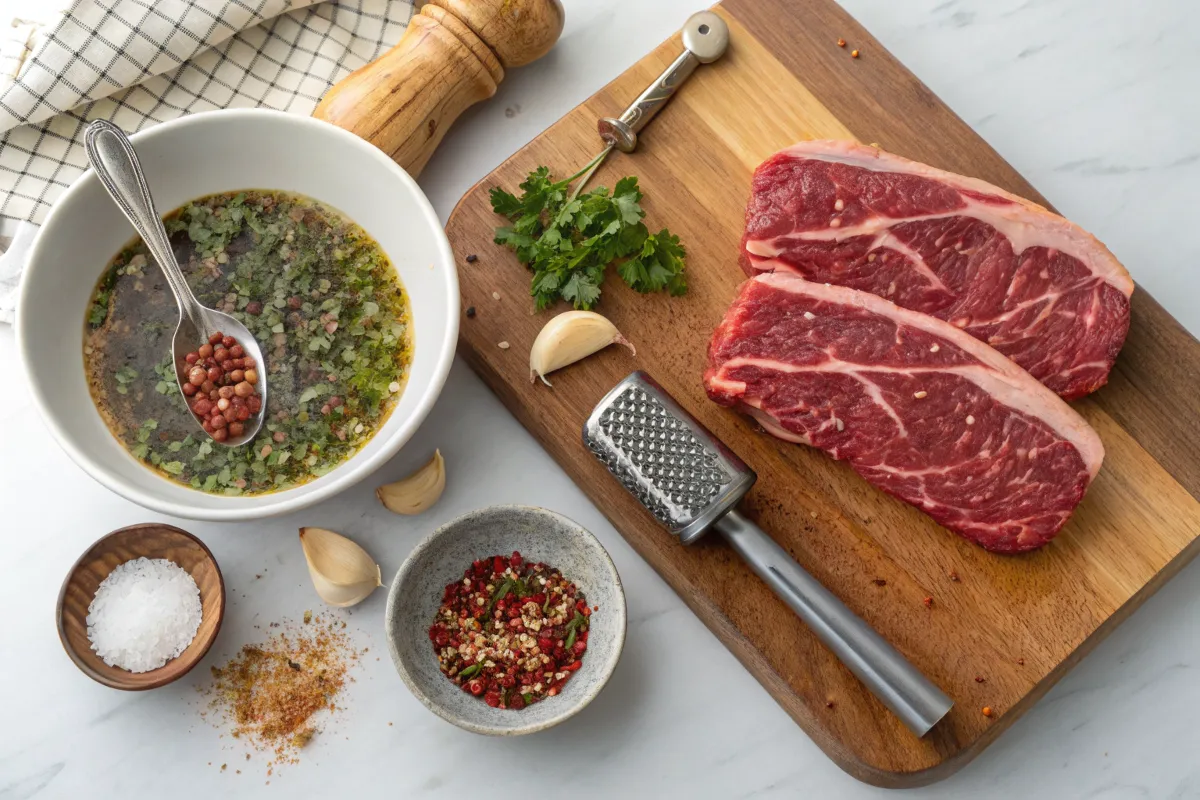Introduction to Sirloin Tip Steak
What is Sirloin Tip Steak?
Sirloin tip steak, often referred to as the “round tip steak,” is a flavorful and versatile cut of beef derived from the round primal of the cow. Unlike the more tender sirloin cut, the sirloin tip steak comes from the muscle just above the knee, making it leaner and slightly firmer in texture. It is prized for its robust beef flavor and is a popular choice for grilling, stir-frying, or marinating.
This steak’s adaptability in recipes stems from its balance between affordability and taste, making it a favorite among home cooks and professional chefs alike. Its lean nature means it is lower in fat, appealing to those looking for healthier meal options. However, its firmness can make proper preparation essential for a tender and delicious result.
Whether you’re hosting a barbecue or preparing a weeknight dinner, sirloin tip steak offers a satisfying dining experience when cooked correctly.
Nutritional Profile of Sirloin Tip Steak
Sirloin tip steak is not only delicious but also packed with essential nutrients. A typical 3-ounce serving provides approximately 150 calories, making it a relatively low-calorie protein source. It is rich in high-quality protein, supplying about 25 grams per serving, which supports muscle growth and repair.
This cut is also a great source of vitamins and minerals, including iron, zinc, and B vitamins like niacin and vitamin B12. These nutrients play vital roles in energy production, immune support, and red blood cell formation. The steak’s low-fat content, typically around 3-5 grams per serving, makes it a healthier alternative to fattier cuts, especially when trimmed of any visible fat.
For health-conscious consumers, sirloin tip steak provides an excellent balance of nutrition, flavor, and versatility in meal planning.
Sirloin Tip Steak vs. Other Cuts: Understanding the Differences
The world of beef cuts can be confusing, but understanding the unique qualities of sirloin tip steak compared to other cuts helps you make informed culinary choices. While it shares the “sirloin” name, sirloin tip steak is distinct from top sirloin steak. The latter is cut from the sirloin primal and is significantly more tender due to its location near less active muscles. Sirloin tip steak, by contrast, comes from the round primal, which is a more exercised part of the cow, leading to a firmer texture.
Compared to ribeye steak, which is known for its marbling and buttery richness, sirloin tip steak is leaner and lower in fat. This makes it an excellent choice for those prioritizing healthier options without compromising flavor. Additionally, sirloin tip steak differs from flank steak in that it has a slightly more compact structure, making it easier to slice and serve evenly.
While cuts like filet mignon and New York strip may dominate fine dining menus, sirloin tip steak stands out as an affordable, flavorful alternative. With proper marinating and cooking techniques, this versatile cut can deliver a tender and enjoyable dining experience rivaling more expensive counterparts.
Selecting and Preparing Sirloin Tip Steak
How to Choose Quality Sirloin Tip Steak at the Butcher
Choosing the perfect sirloin tip steak starts with understanding what to look for at the butcher or grocery store. First, inspect the meat’s color. High-quality sirloin tip steak should have a bright, cherry-red hue, indicating freshness. Avoid steaks with gray or brown spots, as they may signify age or improper storage.
Next, examine the marbling. While sirloin tip steak is naturally lean, a small amount of intramuscular fat can enhance flavor and juiciness. Opt for steaks with even marbling throughout. Additionally, check the thickness of the cut; steaks between ¾ inch and 1 inch thick are ideal for even cooking.
Pay attention to packaging as well. Vacuum-sealed steaks often retain freshness longer, while loosely wrapped cuts may dry out quickly. Don’t hesitate to ask your butcher for guidance—they can recommend the freshest cuts and even suggest cooking tips tailored to the steak. By carefully selecting your sirloin tip steak, you set the stage for a delicious and satisfying meal.
Essential Tools for Preparing Sirloin Tip Steak
Preparing sirloin tip steak to perfection requires a few essential kitchen tools. A sharp chef’s knife is crucial for trimming excess fat and slicing the steak post-cooking. A meat mallet can be used to tenderize the steak, especially if it’s on the thicker side.
For cooking, a cast-iron skillet or grill pan is ideal for achieving a good sear and caramelization, while a meat thermometer ensures precise doneness, preventing overcooking or undercooking. A thermometer with an instant-read feature is particularly useful for lean cuts like sirloin tip steak.
Other handy tools include a marinade brush for basting and a cutting board with grooves to catch juices when slicing. With these tools in hand, you’ll be equipped to handle every step of preparation, ensuring the best possible flavor and texture.
Marinating Techniques to Enhance Flavor and Tenderness
Marinating sirloin tip steak is an effective way to elevate its flavor and improve its tenderness. A good marinade typically includes three key components: an acid, oil, and seasoning. Acids like lemon juice, vinegar, or yogurt help break down muscle fibers, making the steak more tender. Oils such as olive oil or sesame oil coat the steak, ensuring even distribution of spices and herbs while preventing it from drying out during cooking.
For seasoning, a mix of salt, pepper, garlic, and herbs like rosemary or thyme works well. For added depth, you can include soy sauce, Worcestershire sauce, or a splash of red wine in the marinade. Combine the ingredients in a resealable bag, add the steak, and let it sit in the refrigerator for at least 30 minutes to 4 hours. For maximum tenderness, marinate overnight.
While marinating, ensure the steak is fully submerged or evenly coated. If time is short, a quick marinade with strong flavors like garlic and citrus can still yield good results. Once marinated, pat the steak dry with a paper towel before cooking to ensure a proper sear. With the right marinade, your sirloin tip steak will burst with flavor and succulence.
Cooking Methods for Sirloin Tip Steak
Grilling Sirloin Tip Steak: Step-by-Step Guide
Grilling sirloin tip steak imparts a smoky, charred flavor that enhances its natural beefiness. Follow these steps for the perfect grilled steak:
- Preparation: Start by preheating your grill to high heat (450–500°F). While the grill heats, bring the steak to room temperature for 30 minutes. Pat it dry and season generously with salt, pepper, and any desired spices or marinades.
- Searing: Place the steak directly on the grill grates. Sear each side for 2–3 minutes to create a caramelized crust. Rotate the steak 45 degrees halfway through each side to achieve crosshatch grill marks.
- Cooking: Move the steak to a cooler part of the grill or reduce the heat to medium (350–375°F). Continue cooking for 5–7 minutes per side for medium-rare, or until the internal temperature reaches 130–135°F using a meat thermometer.
- Resting: Remove the steak from the grill and place it on a plate. Tent it with foil and let it rest for 5–10 minutes. Resting redistributes the juices, ensuring a tender bite.
- Serving: Slice against the grain into thin strips and serve immediately with your favorite sides.
Grilling is ideal for showcasing the rich flavors of sirloin tip steak, especially when paired with smoky rubs or marinades.
Pan-Searing Sirloin Tip Steak to Perfection
Pan-searing sirloin tip steak is a quick and convenient method that delivers a deliciously crisp crust and juicy interior. Follow these steps:
- Preparation: Heat a cast-iron skillet or heavy-bottomed pan over medium-high heat until it’s smoking hot. While the pan heats, season the steak with salt, pepper, and optional garlic powder or paprika.
- Searing: Add a high-heat oil like canola or avocado oil to the pan. Carefully lay the steak in the skillet, ensuring it doesn’t overcrowd. Press down lightly for even contact. Sear for 2–3 minutes per side without moving the steak to allow a golden-brown crust to form.
- Cooking: Reduce the heat to medium and add aromatics like crushed garlic cloves, rosemary sprigs, or a knob of butter. Baste the steak by tilting the pan and spooning the melted butter over the top.
- Checking Doneness: Insert a meat thermometer into the thickest part of the steak. Cook until the internal temperature reaches 130–135°F for medium-rare.
- Resting and Serving: Remove the steak from the pan and let it rest on a cutting board for 5–7 minutes. Slice thinly against the grain and serve with pan drippings for added flavor.
Pan-searing creates a restaurant-quality finish with minimal effort, perfect for weeknight dinners or elegant meals.
Oven-Baking Sirloin Tip Steak: A Comprehensive Method
Oven-baking is a foolproof way to cook sirloin tip steak evenly while retaining its juices. Here’s how:
- Preparation: Preheat your oven to 400°F. While the oven heats, season the steak with a dry rub or marinade. For added flavor, sear the steak in a hot skillet with oil for 1–2 minutes per side before baking.
- Transfer to Oven: Place the steak on a wire rack set over a baking sheet to allow even air circulation. This prevents the steak from steaming in its juices.
- Cooking: Bake the steak for 10–15 minutes, depending on its thickness and desired doneness. Use a meat thermometer to check the internal temperature: 130–135°F for medium-rare, 140–145°F for medium.
- Resting: Remove the steak from the oven and tent it with foil for 5–10 minutes. This step is crucial for maintaining juiciness and allowing the flavors to meld.
- Serving: Slice the steak thinly against the grain and serve with roasted vegetables or a side of creamy mashed potatoes.
Oven-baking ensures consistent results, making it ideal for beginners or those cooking multiple steaks at once.
Sous Vide Cooking for Optimal Tenderness
Sous vide cooking guarantees perfect doneness and tenderness by precisely controlling the steak’s temperature. Here’s a step-by-step guide:
- Preparation: Preheat your sous vide water bath to 130°F for medium-rare or 140°F for medium. Season the steak with salt, pepper, and optional garlic or herbs. Place the steak in a vacuum-sealed bag or a resealable bag using the water displacement method to remove air.
- Cooking: Submerge the bag in the water bath and cook for 1–2 hours. The long, low-temperature cooking process breaks down tough fibers without overcooking the exterior.
- Finishing: Remove the steak from the bag and pat it dry with paper towels. Heat a cast-iron skillet or grill to high heat. Add oil and sear the steak for 1 minute per side to develop a caramelized crust.
- Serving: Let the steak rest briefly before slicing against the grain. Serve with a drizzle of the juices collected in the sous vide bag for added flavor.
Serving Suggestions and Pairings
Ideal Side Dishes to Complement Sirloin Tip Steak
The right side dishes elevate sirloin tip steak into a balanced, satisfying meal. Classic starches like garlic mashed potatoes or buttery roasted potatoes pair wonderfully with the steak’s robust flavor. Their creamy or crispy textures provide a delightful contrast to the meat’s tender chewiness.
For a lighter option, consider a fresh garden salad with a tangy vinaigrette or roasted vegetables like asparagus, Brussels sprouts, or carrots. These vegetables not only add color to the plate but also enhance the steak’s flavor with their natural sweetness.
Grain-based sides such as quinoa pilaf or wild rice offer a wholesome, hearty accompaniment. Alternatively, you could serve the steak with a slice of warm, crusty bread or a flaky, buttery dinner roll to soak up any flavorful juices.
By thoughtfully selecting sides that complement the steak’s richness, you can create a meal that delights the palate while offering a variety of textures and tastes.
Recommended Sauces and Condiments
Sauces and condiments are the finishing touch that brings out the best in sirloin tip steak. A classic red wine reduction or peppercorn sauce adds depth and enhances the steak’s bold flavor. Both sauces are rich, savory, and perfect for special occasions.
For a creamier option, consider béarnaise sauce or a tangy horseradish cream, which pairs beautifully with the steak’s lean profile. If you prefer a zesty kick, chimichurri sauce—made with fresh parsley, garlic, and olive oil—is an excellent choice.
Barbecue enthusiasts can opt for a smoky BBQ sauce, while Asian-inspired meals might call for a drizzle of soy-based teriyaki glaze or a side of spicy Sriracha aioli. Keep in mind that the sauce should complement rather than overpower the steak, allowing its natural flavors to shine.
Experiment with different sauces to add variety to your sirloin tip steak dishes, making each meal unique.
Wine and Beverage Pairings
Pairing the right wine or beverage with sirloin tip steak enhances its flavors and elevates your dining experience. For wine lovers, a Cabernet Sauvignon is a classic choice. Its bold tannins and dark fruit notes balance the richness of the steak. Merlot or Malbec also work well, offering softer, fruitier profiles that complement the meat’s savoriness.
For beer enthusiasts, a robust stout or porter provides a rich, malty contrast to the steak’s flavor. If you prefer something lighter, a crisp amber ale can offer a refreshing balance.
Non-alcoholic options include a glass of sparkling water with lime or a homemade iced tea, which cleanses the palate between bites. For a touch of sweetness, try a blackberry lemonade to complement the steak’s hearty taste.
The right pairing can turn a simple steak dinner into a restaurant-quality experience at home.
Health Considerations
Health Benefits of Sirloin Tip Steak
Sirloin tip steak is not only flavorful but also packed with nutrients that contribute to a balanced diet. As a lean cut of beef, it is relatively low in fat, making it a healthier option compared to fattier cuts like ribeye or T-bone. A typical 3-ounce serving of sirloin tip steak contains around 25 grams of high-quality protein, essential for muscle repair, growth, and overall bodily functions.
This steak is also an excellent source of essential vitamins and minerals. It provides significant amounts of iron, which supports red blood cell production and prevents anemia, and zinc, which is critical for immune function and wound healing. Additionally, it contains B vitamins, including B12, which aids in energy production and supports nervous system health.
The steak’s low carbohydrate content makes it an ideal choice for those following low-carb or ketogenic diets. When paired with nutrient-rich side dishes, sirloin tip steak contributes to a well-rounded, nutritious meal that supports overall health and wellness.
Potential Health Risks and How to Mitigate Them
While sirloin tip steak offers many health benefits, certain considerations are important to ensure safe and healthy consumption. One potential risk is overconsumption of red meat, which has been linked to an increased risk of heart disease and certain cancers. To mitigate this, balance your intake of red meat with other protein sources like fish, poultry, and plant-based proteins.
Another risk is the potential formation of harmful compounds during high-heat cooking methods like grilling or pan-searing. These compounds, such as heterocyclic amines (HCAs) and polycyclic aromatic hydrocarbons (PAHs), may pose health concerns if consumed in large amounts. To reduce these risks, marinate the steak before cooking, as marinades can lower the formation of HCAs. Additionally, avoid charring the meat and cook it at moderate temperatures when possible.
Lastly, some individuals may need to watch their sodium intake, particularly if they use salt-heavy marinades or seasonings. Opt for low-sodium alternatives and fresh herbs to flavor the steak. By practicing moderation and employing healthy cooking techniques, you can enjoy sirloin tip steak as part of a nutritious, balanced diet.
Frequently Asked Questions
How Do I Tenderize Sirloin Tip Steak?
Tenderizing sirloin tip steak helps improve its texture, making it more enjoyable to eat. A common method is using a meat mallet to pound the steak lightly, breaking down tough muscle fibers. Alternatively, you can use a marinade containing acidic ingredients like lemon juice, vinegar, or yogurt. These acids help to soften the meat while adding flavor.
Enzymatic tenderizers, such as those found in papaya or pineapple juice, are also effective. Simply marinate the steak for 30 minutes to a few hours, depending on the thickness. If you’re short on time, scoring the surface of the steak with shallow cuts can help the marinade penetrate deeper and improve tenderness.
Finally, slow cooking methods or slicing the steak against the grain after cooking can significantly enhance its tenderness, delivering a delicious and satisfying bite.
What Is the Best Cooking Method for Sirloin Tip Steak?
The best cooking method for sirloin tip steak depends on your taste preferences and available equipment. Grilling and pan-searing are popular choices, as they create a flavorful crust while keeping the interior juicy.
For grilling, cook the steak over high heat for 2–3 minutes per side, then finish on medium heat until it reaches the desired doneness. For pan-searing, use a hot skillet with oil and sear the steak for a similar duration, basting with butter for added flavor.
If you prefer even cooking, oven-baking or sous vide methods are excellent options. Sous vide ensures precise doneness, while oven-baking is ideal for larger portions. Each method offers unique results, but proper seasoning and resting the steak before slicing are crucial for all techniques.
How Does Sirloin Tip Steak Differ from Top Sirloin?
Sirloin tip steak and top sirloin are both popular cuts, but they differ in texture, flavor, and use. Sirloin tip steak is cut from the round primal, near the rear of the cow. It is leaner and firmer, making it suitable for marinating or slow cooking to enhance tenderness.
In contrast, top sirloin is from the sirloin primal, located closer to the middle of the cow. This area is less exercised, resulting in a more tender cut with slightly more fat, making it ideal for grilling or pan-searing without additional preparation.
While both cuts are versatile, sirloin tip steak is often more affordable, making it a budget-friendly choice for recipes requiring marination or longer cooking times. Top sirloin, on the other hand, offers a naturally tender bite perfect for quick and simple cooking methods.
Can I Use Sirloin Tip Steak for Stir-Fry Dishes?
Yes, sirloin tip steak is an excellent choice for stir-fry dishes. Its lean profile and firm texture hold up well to the quick, high-heat cooking method typically used for stir-frying.
To prepare the steak for stir-fry, slice it thinly against the grain into bite-sized strips. This slicing method shortens the muscle fibers, making the meat more tender. A brief marinade with soy sauce, garlic, and a touch of cornstarch can enhance both the flavor and tenderness of the steak.
When cooking, preheat the wok or skillet with oil until it’s very hot, then quickly stir-fry the steak for 2–3 minutes. Avoid overcooking, as sirloin tip steak can become tough if cooked for too long. Pair it with fresh vegetables and a flavorful sauce for a delicious, balanced meal.
How Should I Store Leftover Cooked Sirloin Tip Steak?
Proper storage of leftover cooked sirloin tip steak ensures it remains safe to eat and retains its quality. Begin by allowing the steak to cool to room temperature for no more than two hours after cooking. Wrap the steak tightly in aluminum foil or store it in an airtight container to prevent air exposure, which can dry out the meat.
Refrigerate the steak within two hours and consume it within 3–4 days. For longer storage, freeze the steak in a freezer-safe bag or container. Label the package with the date to keep track of freshness.
When reheating, use gentle methods such as warming it in the oven at 250°F or in a skillet over low heat with a splash of broth or water. This helps prevent the steak from drying out and ensures a flavorful meal even after storage.
Is Sirloin Tip Steak Suitable for Slow Cooking?
Yes, sirloin tip steak is well-suited for slow cooking. Its lean nature and firm texture benefit from low and slow cooking methods, which help break down the connective tissue and create a tender, flavorful result.
To slow cook steak , sear it first in a hot skillet to develop a caramelized crust. Transfer the steak to a slow cooker along with your choice of liquid, such as beef broth, wine, or a tomato-based sauce. Add aromatics like garlic, onions, and herbs for additional flavor.
Cook on low heat for 6–8 hours or high heat for 3–4 hours, depending on the recipe. The steak will become fork-tender, making it perfect for shredding or serving alongside hearty vegetables. Slow cooking is an excellent way to transform this budget-friendly cut into a delicious and comforting meal.




